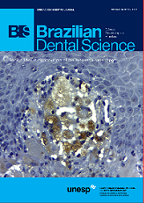Transmigrant impacted mandibular canine: a case report
DOI:
https://doi.org/10.14295/bds.2017.v20i2.1272Abstract
Transmigration of canines across mandibular midline is a rare and elusive phenomenon described in the dental literature. Etiology of this phenomenon is obscure, but in some cases supernumerary teeth may be one of the causes. Surgical extraction is indicated due to pathologic lesions, infection, trauma to the adjacent teeth, pain, ectopic eruption, and interference with prosthesis. The aim of this case report is to describe the treatment of transmigrant impacted mandibular canine near to the mandibular symphysis and to review the literature about its incidence, prevalence, and treatment options. In the anterior mandible, labial access was performed followed by osteotomy and odontosection, for tooth removal. Canine impaction is more prevalent in the maxilla than in the mandible, but canine transmigration is more frequent in the mandible. Females seem to be more affected than males, and the left side is more prevalent than the right. Although the literature is controversial about treatment protocol for transmigrant teeth, several authors indicate its extraction to prevent lesions that are associated with impacted teeth, especially when orthodontic traction is contraindicated due to the position of those teeth.
Downloads
Downloads
Published
How to Cite
Issue
Section
License
Brazilian Dental Science uses the Creative Commons (CC-BY 4.0) license, thus preserving the integrity of articles in an open access environment. The journal allows the author to retain publishing rights without restrictions.
=================




























